Abstract
Rod monochromacy (complete congenital achromatopsia) is inherited as an autosomal recessive trait of unknown genetic location. The disorder is characterized by total absence of color discrimination because retinal cone photoreceptors do not develop; systemic features do not occur. A 20-year-old white female with rod monochromacy presented with short stature (less than 5th percentile), mild developmental delay, premature puberty, small hands and feet (length less than 5th percentile), minimal dysmorphism, and a reproductive history of three consecutive first-trimester miscarriages. Cytogenetic analysis showed 45,XX,rob(14;14) in all 30 cells examined. Southern analysis of DNA from the patient and her phenotypically normal mother and two brothers (her father is deceased) ascertained the parental origin of the 14;14 Robertsonian translocation. Analysis of RFLPs associated with nine VNTR probes and two dinucleotide repeat polymorphisms from chromosome 14 demonstrated that the patient had inherited two copies of a single allele, each of which was maternally derived. A fully informative RFLP analysis of three probes from chromosome 14 enabled reconstruction of the paternal haplotype and showed the lack of any paternal contribution to the subject. These data are consistent with maternal isodisomy for all portions of chromosome 14 tested by these markers. This finding suggests that rod monochromacy maps to chromosome 14, and it emphasizes the importance of uniparental isodisomy to provide a putative chromosomal assignment of a gene for a rare autosomal recessive disorder.
Full text
PDF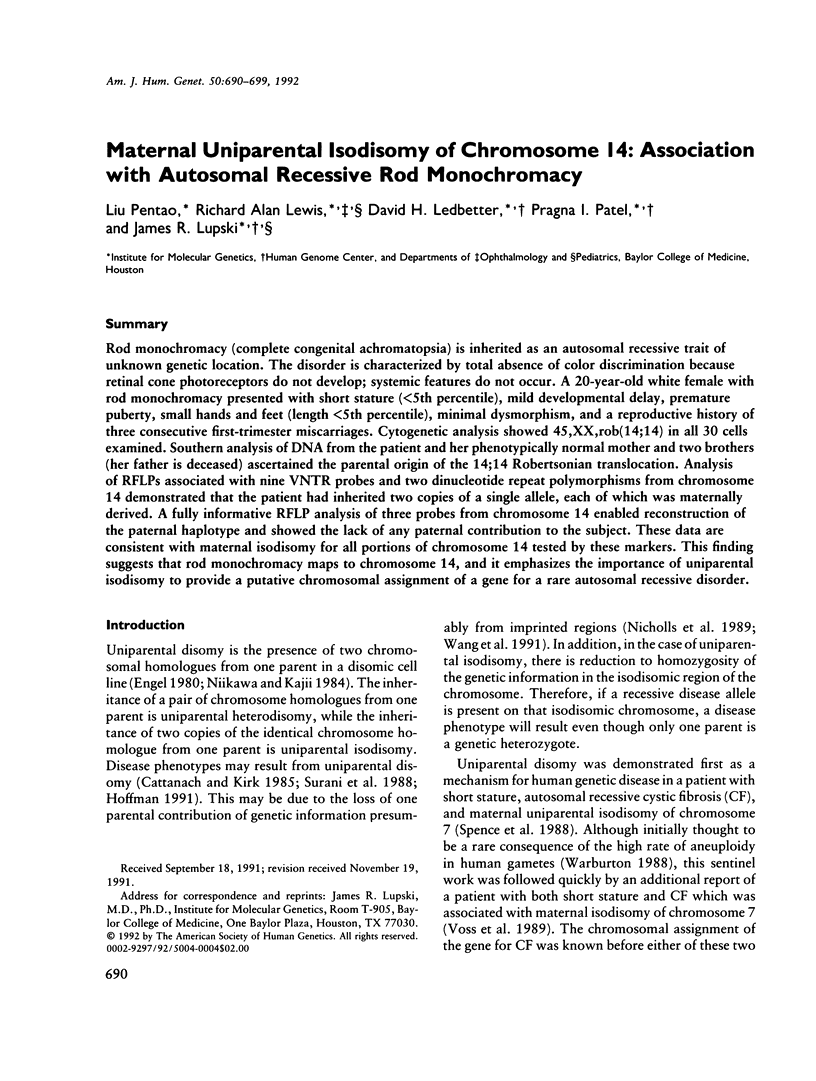
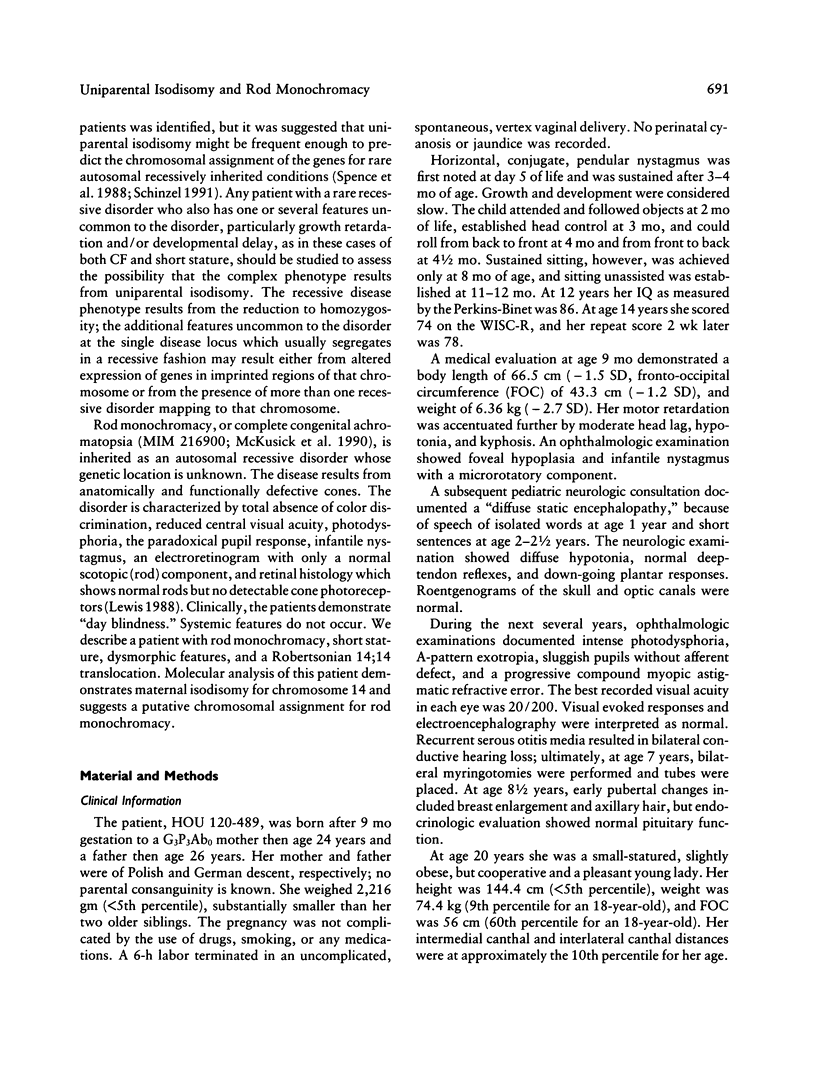



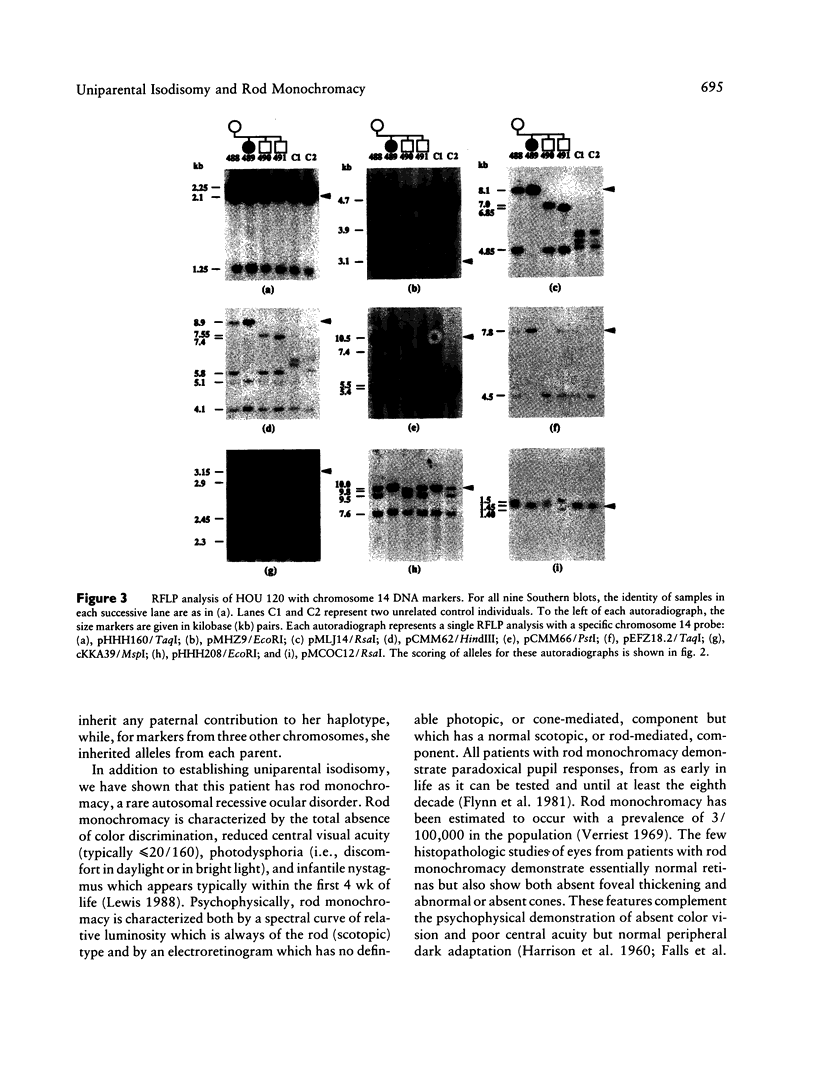
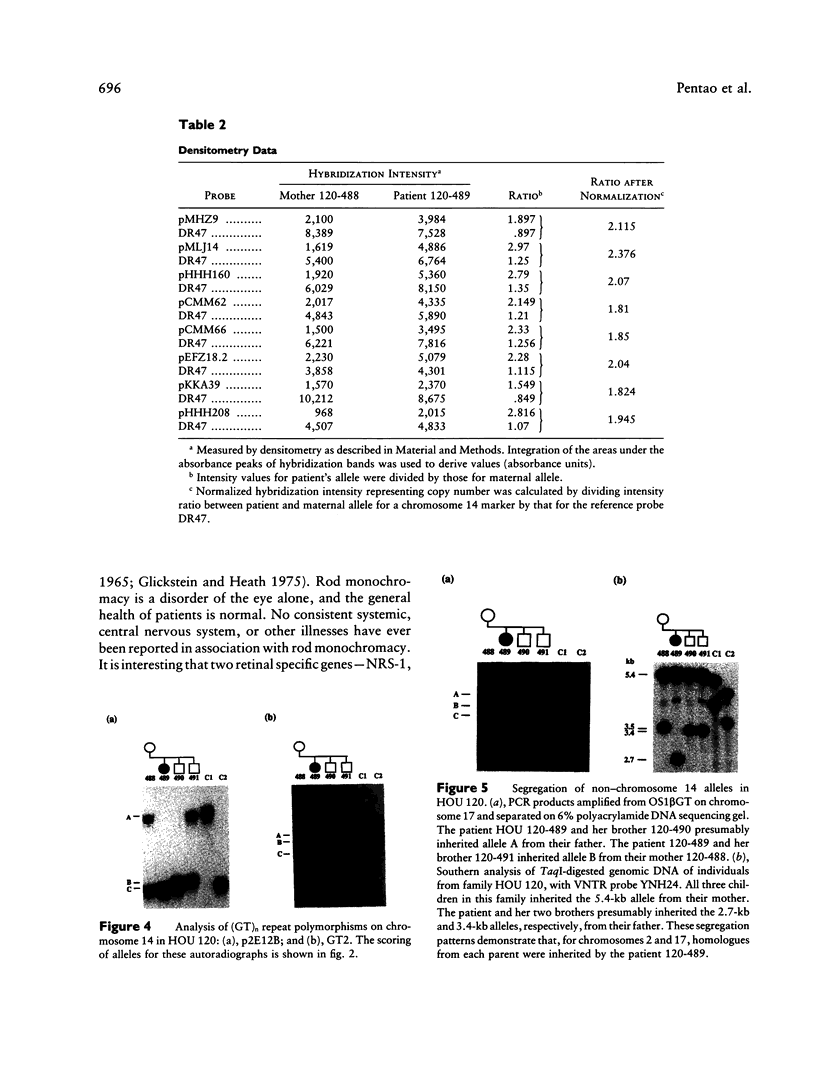

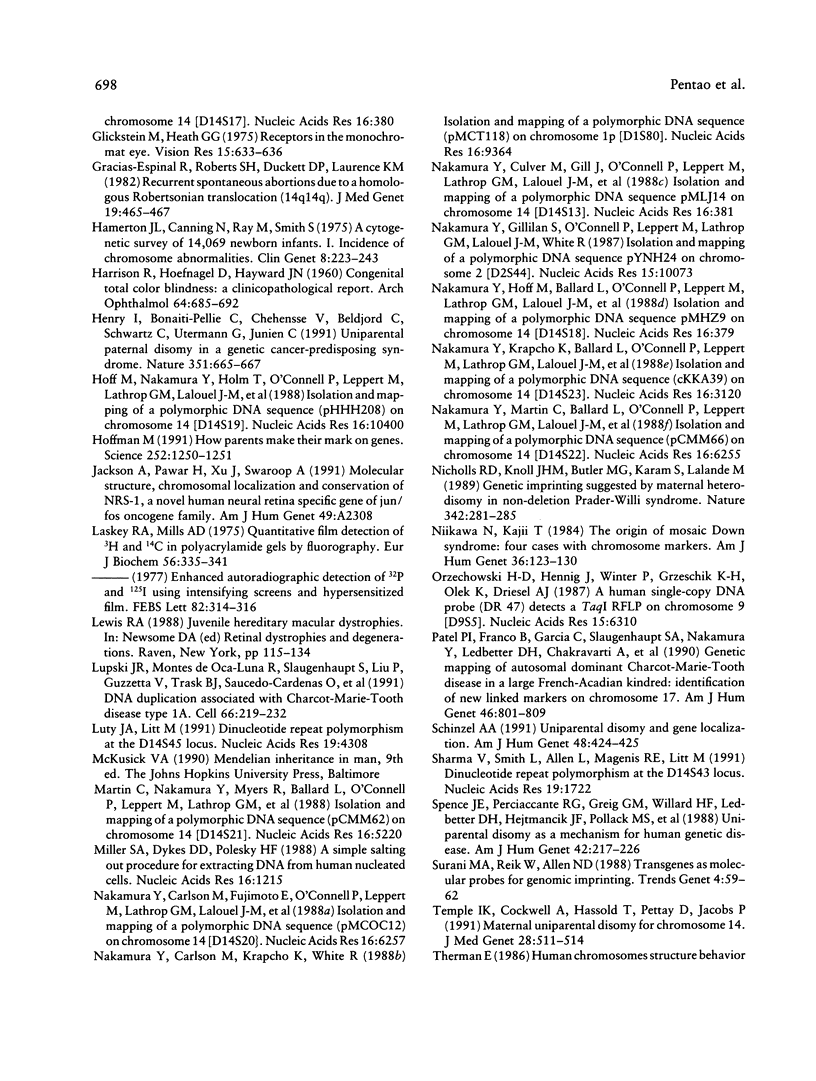

Images in this article
Selected References
These references are in PubMed. This may not be the complete list of references from this article.
- Caspersson T., Hultén M., Lindsten J., Therkelsen A. J., Zech L. Identification of different Robertsonian translocations in man by quinacrine mustard fluorescence analysis. Hereditas. 1971;67(2):213–220. doi: 10.1111/j.1601-5223.1971.tb02375.x. [DOI] [PubMed] [Google Scholar]
- Cattanach B. M., Kirk M. Differential activity of maternally and paternally derived chromosome regions in mice. Nature. 1985 Jun 6;315(6019):496–498. doi: 10.1038/315496a0. [DOI] [PubMed] [Google Scholar]
- Cavenee W. K., Dryja T. P., Phillips R. A., Benedict W. F., Godbout R., Gallie B. L., Murphree A. L., Strong L. C., White R. L. Expression of recessive alleles by chromosomal mechanisms in retinoblastoma. 1983 Oct 27-Nov 2Nature. 305(5937):779–784. doi: 10.1038/305779a0. [DOI] [PubMed] [Google Scholar]
- Engel E. A new genetic concept: uniparental disomy and its potential effect, isodisomy. Am J Med Genet. 1980;6(2):137–143. doi: 10.1002/ajmg.1320060207. [DOI] [PubMed] [Google Scholar]
- Falls H. F., Wolter J. R., Alpern M. Typical total monochromacy. A histological and psychophysical study. Arch Ophthalmol. 1965 Nov;74(5):610–616. doi: 10.1001/archopht.1965.00970040612005. [DOI] [PubMed] [Google Scholar]
- Flynn J. T., Kazarian E., Barricks M. Paradoxical pupil in congenital achromatopsia. Int Ophthalmol. 1981 Mar;3(2):91–96. doi: 10.1007/BF00133420. [DOI] [PubMed] [Google Scholar]
- Franco B., Lai L. W., Patterson D., Ledbetter D. H., Trask B. J., van den Engh G., Iannaccone S., Frances S., Patel P. I., Lupski J. R. Molecular characterization of a patient with del(1)(q23-q25). Hum Genet. 1991 Jul;87(3):269–277. doi: 10.1007/BF00200903. [DOI] [PubMed] [Google Scholar]
- Fujimoto E., Nakamura Y., Payson R., O'Connell P., Leppert M., Lathrop G. M., Lalouel J. M., White R. Isolation and mapping of a polymorphic DNA sequence pEFZ18.2 on chromosome 14 [D14S17]. Nucleic Acids Res. 1988 Jan 11;16(1):380–380. doi: 10.1093/nar/16.1.380. [DOI] [PMC free article] [PubMed] [Google Scholar]
- Glickstein M., Heath G. G. Receptors in the monochromat eye. Vision Res. 1975 Jun;15(6):633–636. doi: 10.1016/0042-6989(75)90276-x. [DOI] [PubMed] [Google Scholar]
- Gracias-Espinal R., Roberts S. H., Duckett D. P., Laurence K. M. Recurrent spontaneous abortions due to a homologous Robertsonian translocation (14q14q). J Med Genet. 1982 Dec;19(6):465–467. doi: 10.1136/jmg.19.6.465. [DOI] [PMC free article] [PubMed] [Google Scholar]
- HARRISON R., HOEFNAGEL D., HAYWARD J. N. Congenital total color blindness: a clincopathological report. Arch Ophthalmol. 1960 Nov;64:685–692. doi: 10.1001/archopht.1960.01840010687010. [DOI] [PubMed] [Google Scholar]
- Hamerton J. L., Canning N., Ray M., Smith S. A cytogenetic survey of 14,069 newborn infants. I. Incidence of chromosome abnormalities. Clin Genet. 1975 Oct;8(4):223–243. doi: 10.1111/j.1399-0004.1975.tb01498.x. [DOI] [PubMed] [Google Scholar]
- Henry I., Bonaiti-Pellié C., Chehensse V., Beldjord C., Schwartz C., Utermann G., Junien C. Uniparental paternal disomy in a genetic cancer-predisposing syndrome. Nature. 1991 Jun 20;351(6328):665–667. doi: 10.1038/351665a0. [DOI] [PubMed] [Google Scholar]
- Hoff M., Nakamura Y., Holm T., O'Connell P., Leppert M., Lathrop G. M., Lalouel J. M., White R. Isolation and mapping of a polymorphic DNA sequence (pHHH208) on chromosome 14 [D14S19]. Nucleic Acids Res. 1988 Nov 11;16(21):10400–10400. doi: 10.1093/nar/16.21.10400. [DOI] [PMC free article] [PubMed] [Google Scholar]
- Hoffman M. How parents make their mark on genes. Science. 1991 May 31;252(5010):1250–1251. doi: 10.1126/science.1925535. [DOI] [PubMed] [Google Scholar]
- Laskey R. A., Mills A. D. Quantitative film detection of 3H and 14C in polyacrylamide gels by fluorography. Eur J Biochem. 1975 Aug 15;56(2):335–341. doi: 10.1111/j.1432-1033.1975.tb02238.x. [DOI] [PubMed] [Google Scholar]
- Lupski J. R., de Oca-Luna R. M., Slaugenhaupt S., Pentao L., Guzzetta V., Trask B. J., Saucedo-Cardenas O., Barker D. F., Killian J. M., Garcia C. A. DNA duplication associated with Charcot-Marie-Tooth disease type 1A. Cell. 1991 Jul 26;66(2):219–232. doi: 10.1016/0092-8674(91)90613-4. [DOI] [PubMed] [Google Scholar]
- Luty J. A., Litt M. Dinucleotide repeat polymorphism at the D14S45 locus. Nucleic Acids Res. 1991 Aug 11;19(15):4308–4308. doi: 10.1093/nar/19.15.4308. [DOI] [PMC free article] [PubMed] [Google Scholar]
- Martin C., Nakamura Y., Myers R., Ballard L., O'Connell P., Leppert M., Lathrop G. M., Lalouel J. M., White R. Isolation and mapping of a polymorphic DNA sequence (pCMM62) on chromosome 14 [D14S21]. Nucleic Acids Res. 1988 Jun 10;16(11):5220–5220. doi: 10.1093/nar/16.11.5220. [DOI] [PMC free article] [PubMed] [Google Scholar]
- Miller S. A., Dykes D. D., Polesky H. F. A simple salting out procedure for extracting DNA from human nucleated cells. Nucleic Acids Res. 1988 Feb 11;16(3):1215–1215. doi: 10.1093/nar/16.3.1215. [DOI] [PMC free article] [PubMed] [Google Scholar]
- Nakamura Y., Carlson M., Fujimoto E., O'Connell P., Leppert M., Lathrop G. M., Lalouel J. M., White R. Isolation and mapping of a polymorphic DNA sequence (pMCOC12) on chromosome 14 [D14S20]. Nucleic Acids Res. 1988 Jul 11;16(13):6257–6257. doi: 10.1093/nar/16.13.6257. [DOI] [PMC free article] [PubMed] [Google Scholar]
- Nakamura Y., Carlson M., Krapcho K., White R. Isolation and mapping of a polymorphic DNA sequence (pMCT118) on chromosome 1p [D1S80]. Nucleic Acids Res. 1988 Oct 11;16(19):9364–9364. doi: 10.1093/nar/16.19.9364. [DOI] [PMC free article] [PubMed] [Google Scholar]
- Nakamura Y., Culver M., Gill J., O'Connell P., Leppert M., Lathrop G. M., Lalouel J. M., White R. Isolation and mapping of a polymorphic DNA sequence pMLJ14 on chromosome 14 [D14S13]. Nucleic Acids Res. 1988 Jan 11;16(1):381–381. doi: 10.1093/nar/16.1.381. [DOI] [PMC free article] [PubMed] [Google Scholar]
- Nakamura Y., Gillilan S., O'Connell P., Leppert M., Lathrop G. M., Lalouel J. M., White R. Isolation and mapping of a polymorphic DNA sequence pYNH24 on chromosome 2 (D2S44). Nucleic Acids Res. 1987 Dec 10;15(23):10073–10073. doi: 10.1093/nar/15.23.10073. [DOI] [PMC free article] [PubMed] [Google Scholar]
- Nicholls R. D., Knoll J. H., Butler M. G., Karam S., Lalande M. Genetic imprinting suggested by maternal heterodisomy in nondeletion Prader-Willi syndrome. Nature. 1989 Nov 16;342(6247):281–285. doi: 10.1038/342281a0. [DOI] [PMC free article] [PubMed] [Google Scholar]
- Niikawa N., Kajii T. The origin of mosaic Down syndrome: four cases with chromosome markers. Am J Hum Genet. 1984 Jan;36(1):123–130. [PMC free article] [PubMed] [Google Scholar]
- Orzechowski H. D., Hennig J., Winter P., Grzeschik K. H., Olek K., Driesel A. J. A human single-copy DNA probe (DR 47) detects a Taq I RFLP on chromosome 9 (D9S5). Nucleic Acids Res. 1987 Aug 11;15(15):6310–6310. doi: 10.1093/nar/15.15.6310. [DOI] [PMC free article] [PubMed] [Google Scholar]
- Patel P. I., Franco B., Garcia C., Slaugenhaupt S. A., Nakamura Y., Ledbetter D. H., Chakravarti A., Lupski J. R. Genetic mapping of autosomal dominant Charcot-Marie-Tooth disease in a large French-Acadian kindred: identification of new linked markers on chromosome 17. Am J Hum Genet. 1990 Apr;46(4):801–809. [PMC free article] [PubMed] [Google Scholar]
- Schinzel A. A. Uniparental disomy and gene localization. Am J Hum Genet. 1991 Feb;48(2):424–425. [PMC free article] [PubMed] [Google Scholar]
- Sharma V., Smith L., Allen L., Magenis R. E., Litt M. Dinucleotide repeat polymorphism at the D14S43 locus. Nucleic Acids Res. 1991 Apr 11;19(7):1722–1722. doi: 10.1093/nar/19.7.1722. [DOI] [PMC free article] [PubMed] [Google Scholar]
- Spence J. E., Perciaccante R. G., Greig G. M., Willard H. F., Ledbetter D. H., Hejtmancik J. F., Pollack M. S., O'Brien W. E., Beaudet A. L. Uniparental disomy as a mechanism for human genetic disease. Am J Hum Genet. 1988 Feb;42(2):217–226. [PMC free article] [PubMed] [Google Scholar]
- Surani M. A., Reik W., Allen N. D. Transgenes as molecular probes for genomic imprinting. Trends Genet. 1988 Mar;4(3):59–62. doi: 10.1016/0168-9525(88)90040-6. [DOI] [PubMed] [Google Scholar]
- Temple I. K., Cockwell A., Hassold T., Pettay D., Jacobs P. Maternal uniparental disomy for chromosome 14. J Med Genet. 1991 Aug;28(8):511–514. doi: 10.1136/jmg.28.8.511. [DOI] [PMC free article] [PubMed] [Google Scholar]
- Therman E., Susman B., Denniston C. The nonrandom participation of human acrocentric chromosomes in Robertsonian translocations. Ann Hum Genet. 1989 Jan;53(Pt 1):49–65. doi: 10.1111/j.1469-1809.1989.tb01121.x. [DOI] [PubMed] [Google Scholar]
- Verriest M. G. Les déficiences de la vision des couleurs. Bull Soc Ophtalmol Fr. 1969 Nov;69(11):901–927. [PubMed] [Google Scholar]
- Voss R., Ben-Simon E., Avital A., Godfrey S., Zlotogora J., Dagan J., Tikochinski Y., Hillel J. Isodisomy of chromosome 7 in a patient with cystic fibrosis: could uniparental disomy be common in humans? Am J Hum Genet. 1989 Sep;45(3):373–380. [PMC free article] [PubMed] [Google Scholar]
- Wang J. C., Passage M. B., Yen P. H., Shapiro L. J., Mohandas T. K. Uniparental heterodisomy for chromosome 14 in a phenotypically abnormal familial balanced 13/14 Robertsonian translocation carrier. Am J Hum Genet. 1991 Jun;48(6):1069–1074. [PMC free article] [PubMed] [Google Scholar]
- Warburton D. Uniparental disomy: a rare consequence of the high rate of aneuploidy in human gametes. Am J Hum Genet. 1988 Feb;42(2):215–216. [PMC free article] [PubMed] [Google Scholar]
- Zhou H. G., Kang X. Z., Zhang Q. Q. Homologous 14q14q Robertsonian translocation in man. Chin Med J (Engl) 1983 Aug;96(8):625–633. [PubMed] [Google Scholar]






